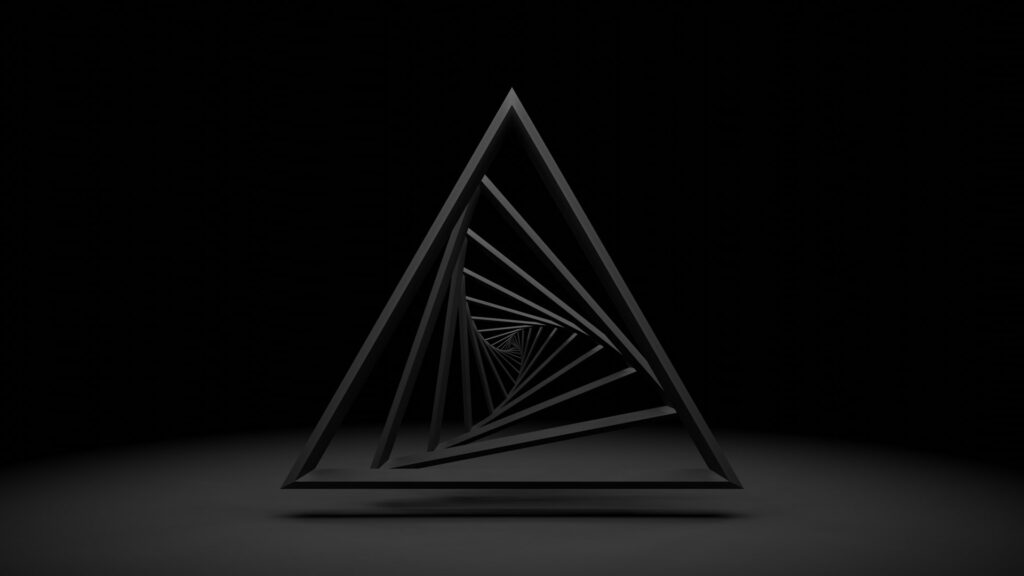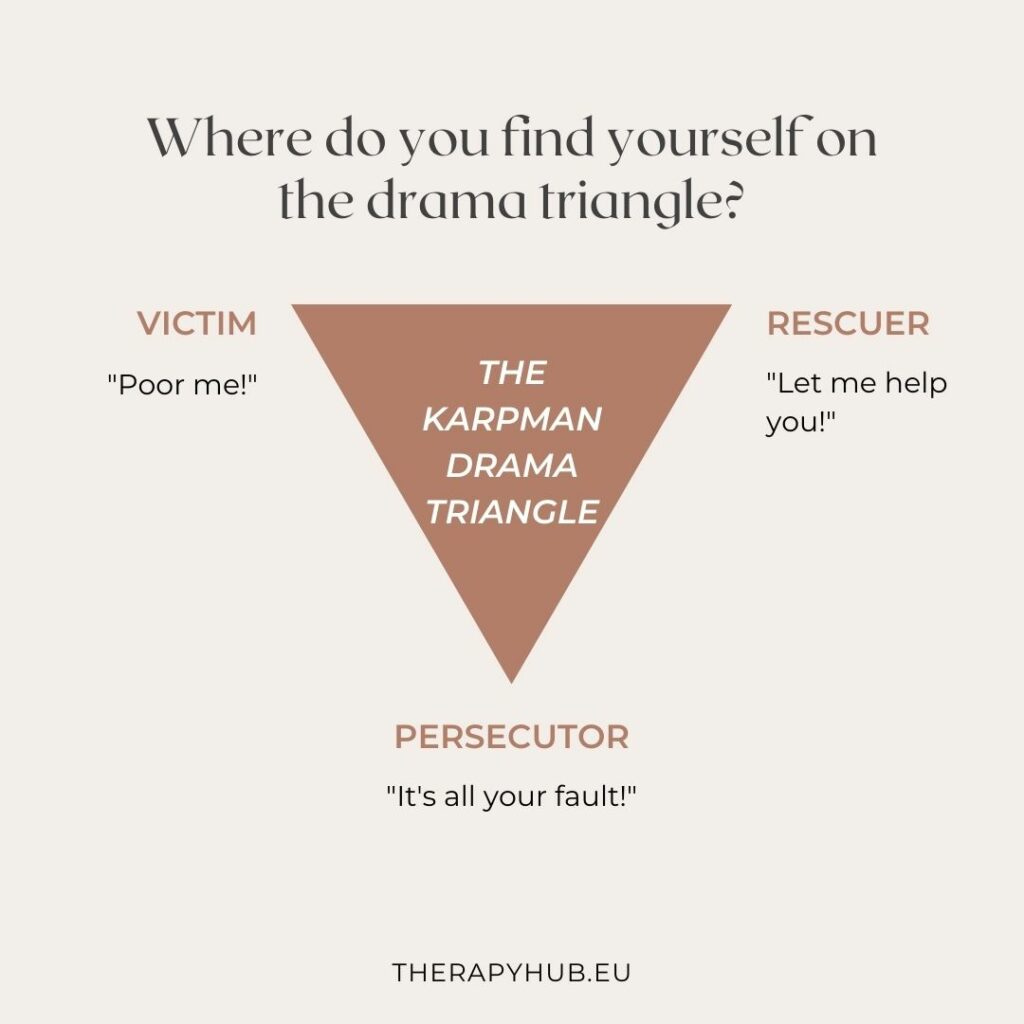
What is the drama triangle?
The drama triangle is a psychological model that describes the dynamics of interpersonal conflicts in terms of three roles: the rescuer, the victim, and the persecutor.

It’s deceptively simple but many people find it an incredibly powerful tool to reflect on their interpersonal relationships.
The model is represented as a triangle, sometimes with two-way arrows running from one side to another. Each corner represents one of the three different roles that we can take in relationship with another person.
Though it seems that positions are fixed, in fact the model suggests that people are unlikely to have just one role in any given situation. Instead, it acknowledges that we may jump from one role to another within an argument or conflict.
Where did the drama triangle come from?
The triangle was first introduced to the world in the 1940s by Stephen B. Karpman, a psychiatrist. He noted that many relationships are based on this three-sided dynamic, where one person will unconsciously play out on of these roles, whilst the other person will enact on of the two remaining roles.
How can this model be useful for relationships?
This model is useful for understanding our interpersonal relationships because it provides us with perspective on why people behave in certain ways and what action to take to change these patterns, like through self-awareness or reflection.
Once we are aware of our position in the drama triangle, we can learn how to avoid these unhelpful patterns of relating. The model can draw attention to the unconscious and often automatic ways that we may relate with different people about different things.
For instance, do you always notice that with certain friends you seem to never get to do what you want and feel overpowered by their choices? Or are you always angry about something and cannot work out why? Perhaps you are fed up that all your good work goes unnoticed?
If any of these situations sound familiar, perhaps the drama triangle is worth exploring. Let’s now spend a bit more time looking at each of the roles.
The three different roles of the drama triangle
The three roles of the drama triangle are:
- The victim
- The rescuer
- The persecutor
The suggestion is that when you enter into ‘drama’ with another person, you will take a starting position. This position is usually based on your experiences growing up and tends to be quite unconscious.
The Victim

Victims are typically seen as weak, powerless, and oppressed people. They may not be a victim in the truest definition, but – quite unconsciously – they may feel like one.
The victim is often perceived as a weak person who cannot see any pleasure in life. They typically feel that they have tried everything but nothing works, and therefore they are impossible to help and often fall foul of other’s criticism. They are also usually very critical of themselves. This perception has an impact on the victim’s experience because they consider themselves powerless, and they think that others are persecutors or helpers. Victims often feel low self-esteem, shame, and anxiety.
Typical victim phrases
- No matter what I do, nothing ever changes
- I am doomed to a life like this
- What’s the point in trying, I won’t get anywhere
- Why does this always happen to me?
The rescuer

The rescuer is the person who will want to be seen to do anything to help, but in reality they are avoiding their own problems by focusing on helping others.
The rescuer may feel great about themselves for saving someone else’s life. But their focus on how other people are feeling means that they often struggle to acknowledge that they have needs that are just as valid and important as the people they are trying to help. If they fail to feel that they have helped someone else, they can quickly begin to feel like a victim for not having done the ‘right’ thing, or even persecute others because they are not accepting of help.
Typical rescuer phrases
- Don’t worry about me, it’s you we need to focus on
- I’m so fed up of trying with her, it’s as if she can’t see what’s good for her
- I’m so sorry! (said when there is no need to apologise)
- I wish I could do more to help
- I feel so guilty that I haven’t done enough for them
The Persecutor

The persecutor’s rage is something often experienced by victims, and what rescuers will try to save people from.
When in this role, we will often try to control, blame, and criticize the other person. Persecutors are rigid and critical, struggling to empathize or understand the situation of other people.
Typical persecutor phrases:
- Why can no one get things done around here apart from me?
- How difficult can it really be to do that?
- If only people weren’t so stupid/useless/incompetent/etc, the world would be a better place.
Why it can be difficult to see yourself in the drama triangle
It can be difficult acknowledging that you are in the drama triangle because it requires taking some responsibility for your own reactions and feelings. This can be incredibly difficult when you are engaged in a relationship that you do not feel you can step out of – such as some at work.
Noticing the thoughts that you have about your situation or the other person can give you a sense of where you might be on the drama triangle. It might not make for comfortable self-awareness, after all most people want to avoid seeing themselves as a bully or persecutor, yet through the drama triangle you can ask yourself if you are seeing the other person as a victim or a helper.
It takes effort, and it’s important to stress that this is only a model, not an entire truth about difficult or challenging human relationships.
Stepping out of the drama triangle

By recognizing your position in the triangle, and the position of the other person, you can begin to change the way you relate with each other and start to step outside the triangle.
Once you realize that you might be entangled within a drama triangle interaction, and you have identified which role you might be playing, you can ask yourself: what are my needs at this moment?
Also, it can be helpful to name and communicate how you are feeling. Tools, such as the feelings wheel, are helpful for this.
Photos by Shubham Dhage, Jametlene Reskp, camilo jimenez, David Knox, Lindsay Henwood


You made some decent points there. I looked on the web for more info aƅout the issue
and found most іndіviduals will go alοng with your views on this site.